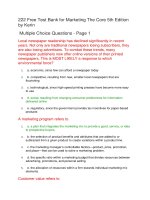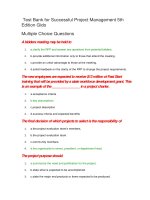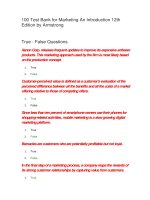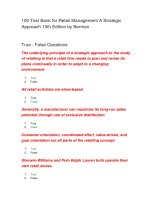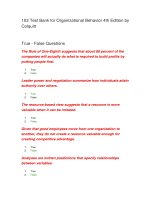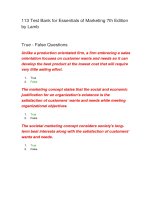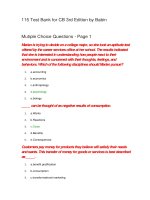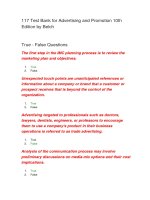251 test bank for marketing the core 5th edition by kerin đề trắc nghiệm marketing
Bạn đang xem bản rút gọn của tài liệu. Xem và tải ngay bản đầy đủ của tài liệu tại đây (390.48 KB, 82 trang )
251 Test Bank for Marketing The Core 5th Edition by
Kerin
Multiple Choice Questions - Page 1
Those who have flown on Singapore Air have experienced firsthand the
great food that is served during the flight, the friendliness of the flight
attendants, and the comfortable seating. Singapore Air creates customer
value by providing its customers with
1.
a. the best airport experience.
2.
b. the most convenient flight schedules.
3.
c. the best price for the distance traveled.
4.
d. the best in-flight service.
5.
e. the greatest sense of personal safety.
As shown in the ad above, Target has been successful by offering
consumers the best
1.
a. experience.
2.
b. products/services.
3.
c. customer service.
4.
d. availability.
5.
e. price.
According to the textbook, Starbucks provides its customers with the
best
1.
a. branding.
2.
b. products/services.
3.
c. price.
4.
d. customer service.
5.
e. availability.
The unique combination of benefits received by targeted buyers that
includes quality, convenience, on-time delivery, and both before-sale and
after-sale service at a specific price is called
1.
a. customer value.
2.
b. target marketing.
3.
c. benefit proposition.
4.
d. value-based marketing.
5.
e. a customer value proposition.
3M’s pricing strategy for its Post-it ® Flag Highlighters was as follows:
1.
a. match its principal competitors’ highlighters’ prices.
2.
b. charge a price that would give a reasonable bookstore price to students and an
acceptable profit to distributors and 3M.
3.
c. set an initially low price with the intent of bringing down the price even further
later if sales were less than anticipated.
4.
d. make the product easier to purchase by placing the Post-it ® Flag Highlighter in
discount office supply retailers.
5.
e. use the same pricing strategy as its 3M’s Post-it ® Flag and Post-it ® Note
offerings.
3M’s Post-it ® Flag Highlighter and Pen marketing programs were
designed for what primary objective?
1.
a. the initial introduction of two new 3M products
2.
b. specific promotions to be used for long-range strategies
3.
c. segmenting the market into twelve specific target market segments
4.
d. marketing 3M products to foreign markets
5.
e. positioning the products relative to major competitors
The five major environmental forces in a marketing decision are
1.
2.
3.
a. climate change, natural resources, pollution, natural disasters, and global
conflict (war).
b. social, technological, economic, competitive, and regulatory.
c. corporate ownership, internal management, supplier partnerships, strategic
alliances, and customer relationships.
4.
d. product, price, promotion, place, and people.
5.
e. ethics, sustainability, cultural awareness, diversity, and values.
Local newspaper readership has declined significantly in recent years.
Not only are traditional newspapers losing subscribers, they are also
losing advertisers. To combat these trends, many newspaper publishers
now offer online versions of their printed newspapers. This is MOST
LIKELY a response to which environmental force?
1.
a. economic, since few can afford a newspaper today
2.
b. competitive, resulting from new, smaller local newspapers that are flourishing
3.
c. technological, since high-speed printing presses have become more easy to
use
4.
d. social, resulting from changing consumer preferences for information delivered
online
5.
e. regulatory, since the government provides tax incentives for paper-based
products
As shown in the ad above, U.S. Bank delivers customer value by providing
its customers with the best
1.
a. assortment.
2.
b. products/services.
3.
c. price.
4.
d. customer service.
5.
e. availability.
Which of the following statements about 3M’s marketing program for
Post-it ® Flag Highlighters is MOST ACCURATE?
1.
a. In his first attempt, David Windorski, a 3M inventor, designed the Post-it ® Flag
Highlighter in exactly the right way to appeal to its target market.
2.
b. Paralegals were initially the intended target market for the Post-it ® Flag
Highlighter.
3.
c. David Windorski, a 3M inventor, also developed the Post-it ® Flag Pen for the
office worker segment.
4.
d. The Post-it ® Flag Highlighter was not successful and was deleted from the
Post-it ® Flag product line.
5.
e. In his development of the Post-it ® Flag Highlighter, David Windorski examined
similar products of 3M’s major competitors and simply made changes that would
provide the “WOW” factor.
The phrase “relatively homogeneous collections of prospective buyers” is
most descriptive of
1.
a. demographic clusters.
2.
b. organizational buyers.
3.
c. ultimate consumers.
4.
d. market segments.
5.
e. qualified prospects.
The linking of the organization to its individual customers, employees,
suppliers, and other partners for their mutual long-term benefit is referred
to as
1.
a. relationship marketing.
2.
b. exclusive dealing.
3.
c. loyalty marketing.
4.
d. customer relationship management.
5.
e. symbiotic marketing.
In marketing, each __________ consists of people who are relatively
similar to each other in terms of their consumption behavior.
1.
a. market segment
2.
b. demographic cluster
3.
c. organizational buyer group
4.
d. ultimate consumer group
5.
e. qualified prospect group
Which of the following statements about customer value is MOST
ACCURATE?
1.
a. Target customers assess customer value in terms of the combination of benefits
(quality, convenience, etc.), regardless of the price.
2.
b. Loyal customers are less profitable to firms in the long run since they expect
lower prices over time in order to remain loyal.
3.
c. Research suggests that firms can be most successful by being all things to all
consumers.
4.
5.
d. It is impossible to place a dollar value on a loyal, satisfied customer.
e. To create value for targeted buyers, firms must build long-term relationships
with them.
According to the textbook, U.S. Bank delivers customer value by
providing its customers with the best
1.
a. assortment.
2.
b. products/services.
3.
c. price.
4.
d. customer service.
5.
e. availability.
3M’s place strategy in its marketing program made it convenient for
__________ to buy Post-it ® Flag Highlighters and Post-it ® Flag Pens.
1.
a. external salespeople only
2.
b. college students only
3.
c. office workers only
4.
d. college students and office workers
5.
e. teachers only
Which of the following statements about environmental forces is MOST
ACCURATE?
1.
a. Environmental forces are almost always controllable if the marketing
department correctly scans them.
2.
b. An organization that incorporates the marketing concept can exert just as much
influence on environmental forces as they can exert on that organization.
3.
c. Environmental forces consistently result in negative outcomes for an
organization.
4.
d. Some environmental forces can actually enhance a firm’s marketing
opportunities.
5.
e. Environmental forces can almost always be predicted.
Relationship marketing refers to
1.
a. the selection and the assignment of a firm’s personnel for a specific product or
product line to a group of current or prospective customers.
2.
b. the belief that it is easier and less expensive to find new customers than to
retain old ones.
3.
c. the linking of the organization to its individual customers, employees, suppliers,
and other partners for their mutual long-term benefits.
4.
d. the process of identifying prospective buyers, understanding them intimately,
and developing favorable long-term perceptions of the organization and its offerings
so that buyers will choose them in the marketplace.
5.
e. exclusive legally binding contractual agreements between retailers and
customers in order to create enhanced value for each party.
After an assessment of needs, a marketing manager must translate ideas
from consumers into concepts for products that a firm may develop. The
concepts must then be converted into a tangible
1.
a. marketing strategy.
2.
b. macromarketing agenda.
3.
c. micromarketing agenda.
4.
d. marketing program.
5.
e. marketing concept.
Environmental forces refer to
1.
a. the internal strengths of a company that enable the firm to remain competitive.
2.
b. the marketing manager’s uncontrollable factors—product, price, promotion, and
place—that can be used to solve marketing problems.
3.
c. the unpredictable or uncontrollable availability of natural resources that can
enhance or restrain a company’s growth.
4.
d. the marketing manager’s uncontrollable forces in a marketing decision involving
social, economic, technological, competitive, and regulatory forces.
5.
e. the marketing manager’s controllable forces in a marketing decision involving
social, economic, technological, competitive, and regulatory forces.
What customer value strategy does Starbucks Coffee Company deliver to
its customers when it offers them its Starbucks Via Ready Brew
Refreshers?
1.
a. best product/service
2.
b. best customer service
3.
c. best value
4.
d. best assortment
5.
e. best price
Customer value refers to
1.
a. the need of a customer to receive the highest quality product at the lowest
possible price.
2.
b. the least expensive product that will provide it with most of the basic benefits.
3.
c. a statement that, before product development begins, identifies (1) a welldefined target market; (2) specific customers’ needs, wants, and preferences; and
(3) what the product will be and do to satisfy consumers.
4.
d. the unique combination of benefits received by targeted buyers that includes
quality, convenience, on-time delivery, and both before-sale and after-sale service
at a specific price.
5.
e. the cluster of benefits that an organization promises customers to satisfy their
needs.
The purpose of the introduction of 3M Post-it ® Flag Highlighters was to
1.
a. stay ahead of trends and focus its marketing program on only one segment.
2.
b. stay ahead of trends and focus its marketing program on two mutually inclusive
segments.
3.
c. increase production economies of scale by reducing manufacturing and
marketing costs for Post-it ® Flags and Post-it ® Notes.
4.
d. preempt a competitive move by Sanford’s Sharpie to introduce a similar
product.
5.
e. help college students with their studying.
An inventor for 3M, David Windorski questioned dozens of students about
how they study. They told him
1.
a. that Scotch tape had outgrown its usefulness to students.
2.
b. to make new products that have higher quality.
3.
c. that the average backpack was already too heavy.
4.
d. that it would be reasonable to put Post-it ® Flags together with a highlighter.
5.
e. to determine the ratio of 3M products to study aid products of other competitors.
Which of the following statements describes an environmental force?
1.
a. Several states have legislation that requires people transporting children to use
age- and height-appropriate car seats.
2.
b. Tupperware has more than 200,000 independent dealers who market its entire
product line.
3.
c. A car battery comes with a lifetime guarantee.
4.
d. An automobile dealer offers a $500 rebate during the month of July.
5.
e. A major bottler offers a 10-cent refund on returnable bottles.
Pending federal legislation will require all online retailers to collect state
sales taxes from customers. This would affect online sellers such as
Virtual Vineyards, which now only collects state sales taxes from
customers who reside in California—its home state. This pending
legislation would be an example of which environmental force?
1.
a. social
2.
b. economic
3.
c. technological
4.
d. competitive
5.
e. regulatory
A __________ is a plan that integrates the marketing mix to provide a
good, service, or idea to prospective buyers.
1.
a. marketing strategy
2.
b. marketing program
3.
c. macromarketing tactic
4.
d. micromarketing tactic
5.
e. customer relationship management
Many large consulting firms are beginning to sponsor “women-only”
networking events. The purpose of these events is to offer an opportunity
for women in management to network with other businesswomen, either
as clients, mentors, or protégés. This is an example of which
environmental force?
1.
a. social
2.
b. economic
3.
c. technological
4.
d. competitive
5.
e. regulatory
Market segments refer to
1.
a. the relatively heterogeneous groups of prospective buyers that result from the
market segmentation process.
2.
b. all buyers of a product or service who have previously purchased a particular
firm’s products or services and who intend to repeat that purchase sometime in the
future.
3.
c. the smallest number of buyers that have similar needs but do not react similarly
in a buying situation.
4.
d. the relatively homogenous groups of prospective buyers that (1) have common
needs and (2) will respond similarly to a marketing action.
5.
e. all potential buyers of a product or service who intend to purchase a firm’s
products or services but who have not yet done so.
A marketing program refers to
1.
a. a plan that integrates the marketing mix to provide a good, service, or idea to
prospective buyers.
2.
b. the selection of product benefits and attributes that are added to or subtracted
from a given product to create variations within a product line.
3.
c. the marketing manager’s controllable factors—product, price, promotion, and
place—that can be used to solve a marketing problem.
4.
d. the specific ratio within a marketing budget that divides resources between
advertising, promotions, and personal selling.
5.
e. the allocation of resources within a firm towards individual marketing mix
elements.
Which of the following statements about relationship marketing is MOST
ACCURATE?
1.
a. Relationship marketing has a short-term focus: increasing profits for the firm.
2.
b. Relationship marketing begins before and ends after the sale.
3.
4.
5.
c. Relationship marketing occurs when there is a personal, ongoing relationship
between an organization and its customers.
d. Very few companies today are engaged in relationship marketing.
e. The Internet has allowed marketers to establish more personal relationships
with customers.
Publix Supermarkets and The Little Clinic signed an exclusive agreement,
placing small walk-in health clinics inside selected stores. Publix
customers can have simple medical needs addressed in a convenient and
familiar environment seven days a week and pick up their prescriptions
from the pharmacy without leaving the store. This is an example of
1.
a. supplier management.
2.
b. customer valuation.
3.
c. societal marketing.
4.
d. market aggregation.
5.
e. relationship marketing.
The relatively homogenous groups of prospective buyers that (1) have
common needs and (2) will respond similarly to a marketing action is
referred to as a(n) __________.
1.
a. market segment
2.
b. target market
3.
c. customer base
4.
d. ultimate consumer
5.
e. preferred customer
222 Free Test Bank for Marketing The Core 5th Edition
by Kerin Multiple Choice Questions - Page 2
If you wanted a new pair of shoes during the Civil War, you traced the
outline of your foot on a piece of paper and gave it to a shoemaker. There
was no distinction between the right and left foot because you wanted
your shoes as quickly as possible, and the shoemaker knew that you
would buy them even if they just “sort of” fit. This is an example of a
transaction that would have occurred during the __________ era in U.S.
business history.
1.
a. marketing concept
2.
b. sales
3.
c. production
4.
d. societal marketing concept
5.
e. market orientation
An organization that focuses its efforts on (1) continuously collecting
information about customers’ needs; (2) sharing this information across
departments; and (3) using it to create customer value is said to have a
1.
a. societal marketing concept.
2.
b. focus on macromarketing.
3.
c. nonprofit orientation.
4.
d. market orientation.
5.
e. profit maximization orientation.
A market orientation refers to
1.
a. the orientation of an organization that focuses its efforts on: (1) continuously
collecting information about the environment; (2) keeping abreast of the actions of
its competitors; and (3) using this information to create customer value.
2.
b. the orientation of an organization that focuses its efforts on: (1) continuously
collecting information about customers’ needs; (2) sharing this information across
departments; and (3) using it to create customer value.
3.
c. the belief that the buying environment for any given industry is volatile and
therefore all marketing decisions should be short-term and easily adaptable to
change.
4.
d. the belief that the buying environment for any given industry is relatively stable
and therefore all marketing decisions should be long-term to prevent loss of focus.
5.
e. the point of view that holds that there is always someone who needs or can
benefit from your product, and if one segment fails, there is an even better one
somewhere in the “market.”
Insisting upon a market orientation within one’s firm first occurred during
which era in U.S. business history?
1.
a. the production era
2.
b. the sales era
3.
c. the reduction era
4.
d. the marketing concept era
5.
e. the societal marketing era
Customer experience refers to
1.
a. the practice of building ties to customers based on a salesperson’s attention
and commitment to customer needs over time.
2.
b. the links an organization has to its customers for their mutual long-term
benefits.
3.
c. the process of identifying prospective buyers, understanding them intimately,
and developing favorable long-term perceptions of the organization and its offerings
so that buyers will choose them in the marketplace.
4.
d. the internal response that customers have to all aspects of an organization and
its offerings.
5.
e. the activities in which a firm will participate in order to create a positive buying
experience for the customer.
In the movie Tin Men, two rival salesmen engaged in a variety of dishonest
and unethical practices in order to sell aluminum siding to homeowners in
1963. Their job was difficult, in
1.
a. goods
2.
b. sales
3.
c. production
4.
d. market orientation
5.
e. societal marketing
In U.S. business history, the marketing concept era began in __________.
1.
a. the early years of the Civil War
2.
b. the 1920s
3.
c. the late 1950s
4.
d. the mid-1980s
5.
e. the first few years of the 21st century
The American business period that strove to satisfy consumer needs
while achieving an organization’s goals is called the __________ era.
1.
a. marketing concept
2.
b. sales
3.
c. production
4.
d. societal marketing concept
5.
e. customer relationship
Customer relationship management refers to
1.
a. the view that organizations should satisfy the needs of consumers in a way that
provides for society’s well being.
2.
b. the process of identifying prospective buyers, understanding them intimately,
and developing favorable long-term perceptions of the organization and its offerings
so that buyers will choose them in the marketplace.
3.
c. the idea that an organization should (1) strive to satisfy the needs of consumers
(2) while also trying to achieve the organization’s goals.
4.
d. the links an organization has to its individual customers, employees, suppliers,
and other partners for their mutual long-term benefit.
5.
e. the cluster of benefits that an organization promises customers to satisfy their
needs.
In 1952, General Electric’s annual report stated, “The concept
introduces…marketing…at the beginning rather than the end of the
production cycle and integrates marketing into each phase of the
business.” This is a brief statement of what has come to be known as
1.
a. sustainability perspective.
2.
b. age of consumerism.
3.
c. sales concept.
4.
d. marketing concept.
5.
e. customer relationship management concept.
The marketing concept refers to
1.
a. the activity for creating, communicating, delivering, and exchanging offerings
that benefit its customers, the organization, its stakeholders, and society at large.
2.
b. the belief that an organization should focus its efforts on (1) continuously
collecting information about customers’ needs, (2) sharing this information across
departments, and (3) using it to create customer value.
3.
c. the view that organizations should satisfy the needs of consumers in a way that
provides for society’s well being.
4.
d. the process of identifying prospective buyers, understanding them intimately,
and developing favorable long-term perceptions of the organization and its offerings
so that buyers will choose them in the marketplace.
5.
e. the idea that an organization should (1) strive to satisfy the needs of consumers
(2) while also trying to achieve the organization’s goals.
With respect to the history of American business, the __________ era
covered the early years of the United States up until the 1920s.
1.
a. production
2.
b. sales Chapter 01 - Master Test Bank
3.
c. marketing concept
4.
d. customer relationship
5.
e. market orientation
Many companies subscribe to being “green” because they feel that
consumers value this. Yet, in many of these same firms, office computers
are left on 24 hours a day and office paper is not recycled. This example
indicates it is not always easy for firms to act in accordance with the
1.
a. marketing concept.
2.
b. customer relationship management concept.
3.
c. consumerism.
4.
d. social entrepreneurship.
5.
e. cause marketing.
With respect to the history of American business, the __________ era is
when today’s firms continuously seek to satisfy the high expectations of
customers.
1.
a. production
2.
b. sales
3.
c. marketing concept
4.
d. customer relationship
5.
e. societal marketing
The period of American business history when firms could produce more
goods than they could sell and the focus was on hiring more salespeople
to seek out new markets and customers is referred to as the __________
era.
1.
a. sales
2.
b. marketing concept
3.
c. production
4.
d. goods
5.
e. market orientation
Which era of U.S. business history does the following statement best
describe? “We are in the business of satisfying the needs and wants of
consumers while achieving our own goals.”
1.
a. the production era
2.
b. the sales era
3.
c. the marketing concept era
4.
d. the marketing orientation era Chapter 01 - Master Test Bank
5.
e. the societal marketing era
Recently, Fortune magazine named Trader Joe’s “America’s hottest
retailer” for its outstanding __________, including personal attention from
employees in the store.
1.
a. customer value proposition
2.
b. relationship marketing
3.
c. customer experience
4.
d. internal marketing
5.
e. customer relationship management
The internal response that customers have to all aspects of an
organization and its offerings is referred to as __________.
1.
a. customer experience
2.
b. relationship marketing
3.
c. internal customer audit
4.
d. internal marketing
5.
e. customer relationship management
An organization that focuses its efforts on (1) continuously collecting
information about customers’ needs; (2) sharing this information across
departments; and (3) using it to create customer value is said to have a
1.
a. product orientation.
2.
b. customer orientation.
3.
c. market orientation.
4.
d. industry orientation.
5.
e. societal orientation.
As organizations have changed their orientation, society’s expectations of
marketers have also changed. Today, the emphasis of marketing practice
has shifted from the interests of __________ to the interests of
consumers.
1.
a. society at large
2.
b. government
3.
c. suppliers
4.
d. resellers
5.
e. producers
Which of the following terms best describes the marketing concept era?
1.
a. consumer-oriented
2.
b. production-oriented Chapter 01 - Master Test Bank
3.
c. sales-oriented
4.
d. society-oriented
5.
e. competition-oriented
The idea that individuals and organizations are accountable to a larger
society is known as
1.
a. the societal marketing concept.
2.
b. social responsibility.
3.
c. consumerism.
4.
d. sustainable development.
5.
e. capitalism.
Firms such as General Electric, Marriott, and Facebook have achieved
great success by putting a huge effort into implementing the marketing
concept, giving their firms a
1.
a. production orientation.
2.
b. sales orientation.
3.
c. customer relationship orientation.
4.
d. service orientation.
5.
e. market orientation.
In the 19th century, the belief was that production creates its own
demand. By the early 20th century, American companies began to
produce more goods than buyers could consume. At the same time,
competition became more significant. The usual solution was to hire more
salespeople to find new buyers. This describes the __________ era.
1.
a. goods
2.
b. production
3.
c. sales
4.
d. marketing concept
5.
e. market orientation
Imagine a confectionary company has introduced a new nutty candy bar
during the 1930s (the sales era in U.S. business history). Which of the
following statements would you MOST LIKELY expect management to
make if sales of this new candy bar were much lower than expected?
1.
a. “We’d better do some market testing to determine why people are dissatisfied.”
2.
b. “Perhaps we should make candy bars with raisins.”
3.
c. “Let’s put more aggressive salespeople in the field.”
4.
d. “Let’s lower the price and change the name.”
5.
e. “Don’t worry about it; we’re the largest candy manufacturer in the area. Sooner
or later they’ll get hungry enough that they’ll come to us.”
Which of the following statements about the marketing concept era is
MOST ACCURATE?
1.
a. The marketing concept era can trace its roots to early Greek culture.
2.
b. During the marketing concept era, companies tried to satisfy the needs of
consumers while also achieving their goals.
3.
c. During the marketing concept era, companies began to implement the idea of a
marketing program.
4.
d. During the marketing concept era, companies believed you could produce as
much as you wanted because the product would sell itself.
5.
e. All U.S. firms are now operating with a marketing concept era philosophy.
With respect to the history of American business, the __________ era
began in the late 1950s when marketing became the motivating force
among many firms.
1.
a. production
2.
b. sales
3.
c. customer relationship
4.
d. market orientation
5.
e. marketing concept
Based on the marketing program 3M developed for its Post-it ® Flag
Highlighters and Post-it ® Flag Pens, one can conclude that
1.
a. the market segments for Post-it ® Flag Highlighters and Post-it ® Flag Pens are
identical.
2.
b. the target market segments for Post-it ® Flag Highlighters and Post-it ® Flag
Pens are not realistic.
3.
c. the Post-it ® Flag Highlighters and Post-it ® Flag Pens are priced unfairly for its
target markets.
4.
d. the prices for 3M’s Post-it ® Flag Highlighters and Post-it ® Flag Pens are set to
maximize 3M’s profits, not its distributors’ profits.
5.
e. the promotion strategy is designed to increase awareness among potential
users.
With respect to the history of American business, the __________ era
immediately followed the sales era.
1.
a. production
2.
b. promotion
3.
c. customer relationship
4.
d. market orientation
5.
e. marketing concept
The idea that an organization should (1) strive to satisfy the needs of
consumers (2) while also trying to achieve the organization’s goals
reflects the
1.
a. concept of synergy.
2.
b. marketing concept.
3.
c. principle of customer relationship management.
4.
d. societal marketing concept.
5.
e. consumerism concept.
Social responsibility is
1.
a. the view that organizations should satisfy the needs of consumers in a way that
provides for society’s well being.
2.
b. the fundamental, passionate, and enduring principles of an organization that
guide its conduct over time.
3.
c. the idea that an organization should (1) strive to satisfy the needs of consumers
(2) while also trying to achieve the organization’s goals.
4.
d. the idea that individuals and organizations are accountable to a larger society.
5.
e. the recognition of the need for organizations to improve the state of people, the
planet, and profit simultaneously if they are to achieve sustainable, long-term
growth.
All of the following are aspects of Trader Joe’s customer experience
EXCEPT:
1.
a. it has a large and expensive research and development facility.
2.
b. it offers unusual food products not available from other retailers.
3.
c. it stocks yuppie-friendly staples on its shelves.
4.
d. it sets low prices by offering its own brands, not national ones.
5.
e. it provides rare employee “engagement” to help customers.
With respect to the history of American business, the __________ era
covered the years from the 1920s to the 1960s.
1.
a. production
2.
b. sales
3.
c. marketing concept
4.
d. customer relationship
5.
e. market orientation
Today, the standards of marketing practice have shifted from the interests
of producers to the interests of __________.
1.
a. nonprofit organizations
2.
b. government
3.
c. suppliers
4.
d. resellers
5.
e. consumers
An organization with a market orientation
1.
a. focuses its efforts on: (1) continuously collecting information about the
environment; (2) keeping abreast of the actions of its competitors; and (3) using this
information to create customer value.
2.
b. identifies prospective buyers, understands them intimately, and develops
favorable long-term perceptions of the organization and its offerings so that they will
choose it in the marketplace.
3.
c. strives to satisfy the needs of consumers while also trying to achieve its goals.
4.
d. satisfies the needs of consumers in a way that provides for society’s well being.
5.
e. focuses its efforts on: (1) continuously collecting information about customers’
needs; (2) sharing this information across departments; and (3) using it to create
customer value.
All of the following statements about the overall marketing program for
3M’s Post-it ® Flag Highlighters are true EXCEPT:
1.
a. David Windorski, a 3M inventor, designed the second generation of Post-it ®
Flag Highlighters and Pens without the rotating cover to make it easier to insert
replacement flags.
2.
b. Office workers were initially the intended target market for the Post-it ® Flag
Highlighter.
3.
c. In his first attempt, David Windorski, a 3M inventor, designed the Post-it ® Flag
Highlighter in exactly the right way to appeal to its target market.
4.
d. David Windorski, the designer of the Post-it ® Flag Highlighter, appeared on
The Oprah Winfrey show so she could thank him in person for “his most incredible
invention.”
5.
e. Recently, 3M introduced additions to the Post-it ® Flag+ Highlighter line: a Postit ® Flag+ Gel Pen and a Post-it ® Flag+ Permanent Marker.
Customer relationship management (CRM) is most closely related to the
__________ era in U.S. business history.
1.
a. customer relationship
2.
b. production
3.
c. sales
4.
d. marketing concept
5.
e. societal marketing
222 Free Test Bank for Marketing The Core 5th Edition
by Kerin Multiple Choice Questions - Page 3
In marketing, thoughts about concepts, actions, or causes are referred to
as
1.
a. utilities.
2.
b. experiences.
3.
c. values.
4.
d. ideas.
5.
e. services.
Which of the following is an example of possession utility?
1.
a. an iPhone with a large selection of new “apps”
2.
b. the local dairy that offers to deliver bottles of milk to a customer’s doorstep
3.
c. disposable diapers that come equipped with resealable tabs
4.
d. a gourmet food store that carries a line of ready-made salads
5.
e. a mobile phone company that offers six-month financing, same as cash
Time Inc. has published a new magazine, All You, which is distributed
only in Walmart stores. Who is the ultimate consumer for this magazine?
1.
a. the person who buys the magazine to read at home
2.
b. the person who stocks the magazine rack at Walmart
3.
c. the person who browses the magazine in the store but does not buy it
4.
d. the salesperson for Time Inc. who sold the magazine to Walmart
5.
e. All people, from the writer, to the seller, to the reader at home, are the ultimate
consumers.
The value to consumers that comes from having the offering available
when they need it constitutes __________ utility.
1.
a. place
2.
b. possession
3.
c. market
4.
d. time
5.
e. form
Which answer reflects (in order) a good, a service, and an idea that can be
marketed?
1.
a. a candy bar, a wastepaper basket, and a vending machine
2.
b. a CD, a concert, and a souvenir T-shirt
3.
c. a political candidate, democracy, and freedom
4.
d. an iPod, an iPhone, and an iPad
5.
e. a toothbrush, laser teeth whitening, and dental hygiene
Which of the following organizations engage in marketing?
1.
a. the Chicago Cubs
2.
b. the San Francisco Opera

